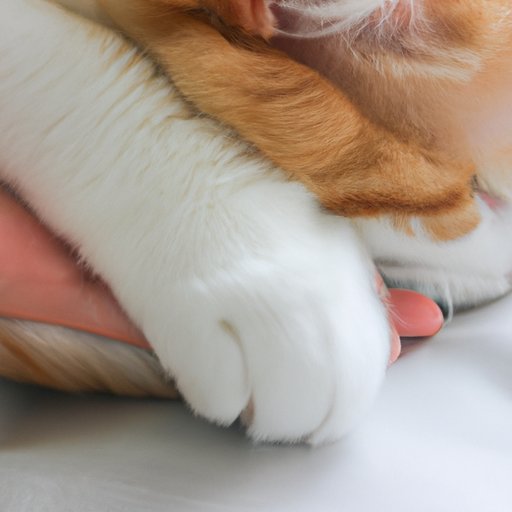
Can You Declaw a Cat?
Cat scratching is a typical behavior that every cat owner will encounter at some point in the life of the cat. While it’s natural for cats to scratch, their claws can cause damage to furniture, carpets, and even people. As a result, pet owners may consider declawing their cat to eliminate the problem of scratching. However, the procedure of declawing can be harmful to a cat’s health, behavior, and well-being. This article will explore the ethical, physical, and behavioral ramifications of declawing, as well as alternatives to declawing that can help keep your cat’s claws intact.
The Ethics of Declawing Cats: What Every Pet Owner Should Know
Declawing a cat is a surgical procedure that entails removing the entire or part of the animal’s claws. The surgery involves surgically amputating the cat’s claws or using a laser to remove the claw and bone. The cat’s claws are a crucial part of their anatomy, and declawing a cat can have detrimental effects on their physical and emotional well-being.
The arguments for declawing cats center on the fact that cats can cause damage to furniture, and declawing is a solution to this problem. However, there are numerous alternatives to declawing that can help prevent cats from scratching furniture or people.
The ethical issues surrounding declawing revolve around the fact that declawing a cat is not a necessary medical procedure but a convenience for the owner. It is believed to be inhumane to remove an essential part of a cat’s anatomy, which can cause long-term pain and a reduction of natural behavior.
Alternatives to Declawing: How to Keep Your Furniture Safe Without Harming Your Cat
There are many alternatives to declawing that can help manage cat scratching behavior. One method is providing a dedicated scratching post or pad for the cat to scratch. Scratching posts come in a wide range of styles and materials, including sisal, carpet, wood, and fabric. The post should be tall enough that the cat can stretch out and scratch, and stable enough that it does not tip over.
Another alternative to declawing is using cat deterrents to discourage scratching behavior. Deterrents include double-sided tape, aluminum foil, and spray repellents with a bitter taste. Electrical mats can also be placed near the furniture or carpets to discourage the cat from approaching. However, cats need to be taught which surfaces they can and cannot scratch. Cats can be trained to scratch these alternatives, in addition to using positive reinforcement techniques, such as treats and praise.
Cat owners can also trim their cat’s claws regularly to keep them short and smooth, which reduces the damage and pain caused by scratching.
The Physical and Psychological Effects of Declawing on Cats: Is it Worth the Risk?
Declawing a cat can cause behavioral and physical problems for the cat. The immediate risks associated with surgery include pain, infection, bleeding, nerve damage, and abnormal nail growth. In the long term, declawing can cause chronic pain, arthritis, and behavioral problems, such as litter box avoidance, aggression, and depression. Declawed cats cannot defend themselves adequately because their claws are their primary means of defense. This can make them feel vulnerable and lead to long-term psychological problems.
Declawed cats may also become biters because they are no longer equipped with claws to defend themselves. Cat owners should understand that declawing their cats increases the risk of behavioral and physical problems arising, thus it is crucial for cats to maintain their natural claws.
The Debate Over Declawing: Expert Opinions and Real-Life Experiences
Many animal welfare organizations oppose declawing because of its significant negative impact on the cat. The American Society for the Prevention of Cruelty to Animals (ASPCA) is strongly against declawing except in rare cases where its medical necessities justify it. The Humane Society of the United States (HSUS) advises against declawing and recommends that pet owners find alternatives to cat scratching.
Real-life experiences of people who have declawed their cats have shown that it causes long-term behavioral and physical problems. Declawed cats may become shy or withdrawn because of pain and anxiety. They may also develop a fear of litter boxes and resort to other areas in the house. Some declawed cats have been known to develop aggression and other behavioral issues.
Ultimately, the debate over declawing remains a hot topic among animal welfare organizations, veterinary professionals, pet owners, and cat lovers.
Understanding Your Cat’s Claws: Tips for Managing Scratching Behavior Safely and Humanely
Cats’ claws are a crucial part of their anatomy, and cat owners should understand their natural behavior to manage their scratching behavior safely and humanely. Cat owners can use positive reinforcement techniques, such as rewarding their cat when they scratch on the designated surfaces. Cat owners should offer many types of scratching surfaces that mimic the natural surfaces that cats use in the wild, such as rough bark or tree stumps.
Cat owners should never punish their cats if they scratch in inappropriate areas but instead redirect them towards the appropriate area. Cat owners should provide many toys and interactive games to keep cats entertained and active. Cat owners should also ensure that cats have a routine, feeding them at specific times and offering plenty of fresh water.
Conclusion
In conclusion, cat owners have various alternatives to declawing, making it unnecessary and inhumane to remove essential parts of a cat’s anatomy. Declawing can cause physical and behavioral problems in cats, making it a non-permanent solution to the problem of cat scratching. It is essential to understand a cat’s behavior and natural instincts to encourage safe and humane behavior. Cat owners should provide appropriate surfaces and many toys, regularly trim their claws, be patient when training, and focus on positive reinforcement. Finally, whether or not to declaw a cat remains a personal decision, but cat owners should educate themselves on the advantages and consequences before making the decision.




